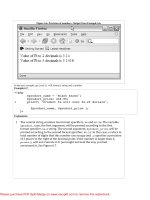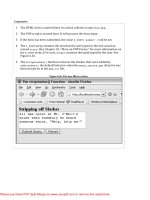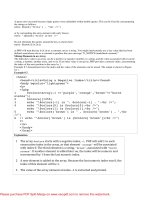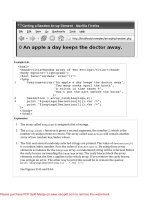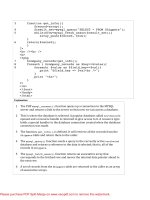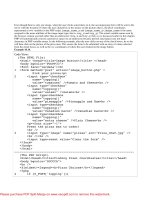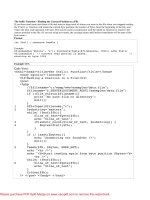Probability and Statistics by Example pptx
Bạn đang xem bản rút gọn của tài liệu. Xem và tải ngay bản đầy đủ của tài liệu tại đây (5.29 MB, 373 trang )
Probability and Statistics by Example: I
Probability and statistics are as much about intuition and problem solving, as
they are about theorem proving. Because of this, students can find it very
difficult to make a successful transition from lectures to examinations to practice,
since the problems involved can vary so much in nature. Since the subject is
critical in many modern applications such as mathematical finance, quantitative
management, telecommunications, signal processing, bioinformatics, as well as
traditional ones such as insurance, social science and engineering, the authors
have rectified deficiencies in traditional lecture-based methods by collecting
together a wealth of exercises for which they’ve supplied complete solutions.
These solutions are adapted to the needs and skills of students. To make it of
broad value, the authors supply basic mathematical facts as and when they are
needed, and have sprinkled some historical information throughout the text.
Probability and Statistics
by Example
Volume I. Basic Probability and Statistics
Y. SUHOV
University of Cambridge
M. KELBERT
University of Wales–Swansea
cambridge university press
Cambridge, New York, Melbourne, Madrid, Cape Town, Singapore, São Paulo
Cambridge University Press
The Edinburgh Building, Cambridge cb2 2ru,UK
First published in print format
isbn-13 978-0-521-84766-7
isbn-13 978-0-521-61233-3
isbn-13 978-0-511-13283-4
© Cambridge University Press 2005
Informationonthistitle:www.cambrid
g
e.or
g
/9780521847667
This publication is in copyright. Subject to statutory exception and to the provision of
relevant collective licensing agreements, no reproduction of any part may take place
without the written permission of Cambridge University Press.
isbn-10 0-511-13283-2
isbn-10 0-521-84766-4
isbn-10 0-521-61233-0
Cambridge University Press has no responsibility for the persistence or accuracy of urls
for external or third-party internet websites referred to in this publication, and does not
guarantee that any content on such websites is, or will remain, accurate or appropriate.
Published in the United States of America by Cambridge University Press, New York
www.cambridge.org
hardback
p
a
p
erback
p
a
p
erback
eBook (NetLibrary)
eBook (NetLibrary)
hardback
Contents
Preface page vii
Part I Basic probability 1
1 Discrete outcomes 3
1.1 A uniform distribution 3
1.2 Conditional Probabilities. The Bayes Theorem. Independent trials 6
1.3 The exclusion–inclusion formula. The ballot problem 27
1.4 Random variables. Expectation and conditional expectation.
Joint distributions 33
1.5 The binomial, Poisson and geometric distributions. Probability
generating, moment generating and characteristic functions 54
1.6 Chebyshev’s and Markov’s inequalities. Jensen’s inequality. The Law
of Large Numbers and the De Moivre–Laplace Theorem 75
1.7 Branching processes 96
2 Continuous outcomes 108
2.1 Uniform distribution. Probability density functions. Random variables.
Independence 108
2.2 Expectation, conditional expectation, variance, generating function,
characteristic function 142
2.3 Normal distributions. Convergence of random variables
and distributions. The Central Limit Theorem 168
Part II Basic statistics 191
3 Parameter estimation 193
3.1 Preliminaries. Some important probability distributions 193
3.2 Estimators. Unbiasedness 204
3.3 Sufficient statistics. The factorisation criterion 209
3.4 Maximum likelihood estimators 213
3.5 Normal samples. The Fisher Theorem 215
v
vi Contents
3.6 Mean square errors. The Rao–Blackwell Theorem.
The Cramér–Rao inequality 218
3.7 Exponential families 225
3.8 Confidence intervals 229
3.9 Bayesian estimation 233
4 Hypothesis testing 242
4.1 Type I and type II error probabilities. Most powerful tests 242
4.2 Likelihood ratio tests. The Neyman–Pearson Lemma and beyond 243
4.3 Goodness of fit. Testing normal distributions, 1: homogeneous samples 252
4.4 The Pearson
2
test. The Pearson Theorem 257
4.5 Generalised likelihood ratio tests. The Wilks Theorem 261
4.6 Contingency tables 270
4.7 Testing normal distributions, 2: non-homogeneous samples 276
4.8 Linear regression. The least squares estimators 289
4.9 Linear regression for normal distributions 292
5 Cambridge University Mathematical Tripos examination questions
in IB Statistics (1992–1999) 298
Appendix 1 Tables of random variables and probability distributions 346
Appendix 2 Index of Cambridge University Mathematical Tripos
examination questions in IA Probability (1992–1999) 349
Bibliography 352
Index 358
Preface
The original motivation for writing this book was rather personal. The first author, in the
course of his teaching career in the Department of Pure Mathematics and Mathematical
Statistics (DPMMS), University of Cambridge, and St John’s College, Cambridge, had
many painful experiences when good (or even brilliant) students, who were interested
in the subject of mathematics and its applications and who performed well during their
first academic year, stumbled or nearly failed in the exams. This led to great frustration,
which was very hard to overcome in subsequent undergraduate years. A conscientious
tutor is always sympathetic to such misfortunes, but even pointing out a student’s obvious
weaknesses (if any) does not always help. For the second author, such experiences were
as a parent of a Cambridge University student rather than as a teacher.
We therefore felt that a monograph focusing on Cambridge University mathematics
examination questions would be beneficial for a number of students. Given our own
research and teaching backgrounds, it was natural for us to select probability and statistics
as the overall topic. The obvious starting point was the first-year course in probability
and the second-year course in statistics. In order to cover other courses, several further
volumes will be needed; for better or worse, we have decided to embark on such a project.
Thus our essential aim is to present the Cambridge University probability and statis-
tics courses by means of examination (and examination-related) questions that have been
set over a number of past years. Following the decision of the Board of the Faculty of
Mathematics, University of Cambridge, we restricted our exposition to the Mathematical
Tripos questions from the years 1992–1999. (The questions from 2000–2004 are available
online at Next, we included some IA Probability reg-
ular example sheet questions from the years 1992–2003 (particularly those considered as
difficult by students). Further, we included the problems from Specimen Papers issued in
1992 and used for mock examinations (mainly in the beginning of the 1990s) and selected
examples from the 1992 list of so-called sample questions. A number of problems came
from example sheets and examination papers from the University of Wales-Swansea.
Of course, Cambridge University examinations have never been easy. On the basis of
examination results, candidates are divided into classes: first, second (divided into two
categories: 2.1 and 2.2) and third; a small number of candidates fail. (In fact, a more
detailed list ranking all the candidates in order is produced, but not publicly disclosed.)
The examinations are officially called the ‘Mathematical Tripos’, after the three-legged
stools on which candidates and examiners used to sit (sometimes for hours) during oral
vii
viii Preface
examinations in ancient times. Nowadays all examinations are written. The first-year of
the three-year undergraduate course is called Part IA, the second Part IB and the third
Part II.
For example, in May–June of 2003 the first-year mathematics students sat four exam-
ination papers; each lasted three hours and included 12 questions from two subjects.
The following courses were examined: algebra and geometry, numbers and sets, analysis,
probability, differential equations, vector calculus, and dynamics. All questions on a given
course were put in a single paper, except for algebra and geometry, which appears in two
papers. In each paper, four questions were classified as short (two from each of the two
courses selected for the paper) and eight as long (four from each selected course). A can-
didate might attempt all four short questions and at most five long questions, no more than
three on each course; a long question carries twice the credit of a short one. A calculation
shows that if a student attempts all nine allowed questions (which is often the case), and
the time is distributed evenly, a short question must be completed in 12–13 minutes and
a long one in 24–25 minutes. This is not easy and usually requires special practice; one
of the goals of this book is to assist with such a training programme.
The pattern of the second-year examinations has similarities but also differences. In
June 2003, there were four IB Maths Tripos papers, each three hours long and containing
nine or ten short and nine or ten long questions in as many subjects selected for a given
paper. In particular, IB statistics was set in Papers 1, 2 and 4, giving a total of six
questions. Of course, preparing for Part IB examinations is different from preparing for
Part IA; we comment on some particular points in the corresponding chapters.
For a typical Cambridge University student, specific preparation for the examinations
begins in earnest during the Easter (or Summer) Term (beginning in mid-April). Ideally,
the work might start during the preceding five-week vacation. (Some of the examination
work for Parts IB and II, the computational projects, is done mainly during the summer
vacation period.) As the examinations approach, the atmosphere in Cambridge can become
rather tense and nervous, although many efforts are made to diffuse the tension. Many
candidates expend a great deal of effort in trying to calculate exactly how much work
to put into each given subject, depending on how much examination credit it carries and
how strong or weak they feel in it, in order to optimise their overall performance. One
can agree or disagree with this attitude, but one thing seemed clear to us: if the students
receive (and are able to digest) enough information about and insight into the level and
style of the Tripos questions, they will have a much better chance of performing to the
best of their abilities. At present, owing to great pressures on time and energy, most
of them are not in a position to do so, and much is left to chance. We will be glad
if this book helps to change this situation by alleviating pre-examination nerves and by
stripping Tripos examinations of some of their mystery, at least in respect of the subjects
treated here.
Thus, the first reason for this book was a desire to make life easier for the students.
However, in the course of working on the text, a second motivation emerged, which we
feel is of considerable professional interest to anyone teaching courses in probability and
statistics. In 1991–2 there was a major change in Cambridge University to the whole
Preface ix
approach to probabilistic and statistical courses. The most notable aspect of the new
approach was that the IA Probability course and the IB Statistics course were redesigned
to appeal to a wide audience (200 first-year students in the case of IA Probability and
nearly the same number of the second-year students in the case of IB Statistics). For a large
number of students, these are the only courses from the whole of probability and statistics
which they attend during their undergraduate years. Since more and more graduates in
the modern world have to deal with theoretical and (especially) applied problems of a
probabilistic or statistical nature, it is important that these courses generate and maintain a
strong and wide appeal. The main goal shifted, moving from an academic introduction to
the subject towards a more methodological approach which equips students with the tools
needed to solve reasonable practical and theoretical questions in a ‘real life’ situation.
Consequently, the emphasis in IA Probability moved further away from sigma-algebras,
Lebesgue and Stiltjies integration and characteristic functions to a direct analysis of various
models, both discrete and continuous, with the aim of preparing students both for future
problems and for future courses (in particular, Part IB Statistics and Part IB/II Markov
chains). In turn, in IB Statistics the focus shifted towards the most popular practical
applications of estimators, hypothesis testing and regression. The principal determination
of examination performance in both IA Probability and IB Statistics became students’
ability to choose and analyse the right model and accurately perform a reasonable amount
of calculation rather than their ability to solve theoretical problems.
Certainly such changes (and parallel developments in other courses) were not always
unanimously popular among the Cambridge University Faculty of Mathematics, and
provoked considerable debate at times. However, the student community was in general
very much in favour of the new approach, and the ‘redesigned’ courses gained increased
popularity both in terms of attendance and in terms of attempts at examination questions
(which has become increasingly important in the life of the Faculty of Mathematics). In
addition, with the ever-growing prevalence of computers, students have shown a strong
preference for an ‘algorithmic’ style of lectures and examination questions (at least in the
authors’ experience).
In this respect, the following experience by the first author may be of some interest.
For some time I have questioned former St John’s mathematics graduates, who now have
careers in a wide variety of different areas, about what parts of the Cambridge University
course they now consider as most important for their present work. It turned out that the
strongest impact on the majority of respondents is not related to particular facts, theorems,
or proofs (although jokes by lecturers are well remembered long afterwards). Rather
they appreciate the ability to construct a mathematical model which represents a real-life
situation, and to solve it analytically or (more often) numerically. It must therefore be
acknowledged that the new approach was rather timely. As a consequence of all this, the
level and style of Maths Tripos questions underwent changes. It is strongly suggested
(although perhaps it was not always achieved) that the questions should have a clear
structure where candidates are led from one part to another.
The second reason described above gives us hope that the book will be interesting
for an audience outside Cambridge. In this regard, there is a natural question: what is
x Preface
the book’s place in the (long) list of textbooks on probability and statistics. Many of the
references in the bibliography are books published in English after 1991, containing the
terms ‘probability’ or ‘statistics’ in their titles and available at the Cambridge University
Main and Departmental Libraries (we are sure that our list is not complete and apologise
for any omission).
As far as basic probability is concerned, we would like to compare this book with
three popular series of texts and problem books, one by S. Ross [Ros1–Ros6], another
by D. Stirzaker [St1–St4], and the third by G. Grimmett and D. Stirzaker [GriS1–GriS3].
The books by Ross and Stirzaker are commonly considered as a good introduction to the
basics of the subject. In fact, the style and level of exposition followed by Ross has been
adopted in many American universities. On the other hand, Grimmett and Stirzaker’s
approach is at a much higher level and might be described as ‘professional’. The level of
our book is intended to be somewhere in-between. In our view, it is closer to that of Ross
or Stirzaker, but quite far away from them in several important aspects. It is our feeling
that the level adopted by Ross or Stirzaker is not sufficient to get through Cambridge
University Mathematical Tripos examinations with Class 2.1 or above. Grimmett and
Stirzaker’s books are of course more than enough – but in using them to prepare for
an examination the main problem would be to select the right examples from among a
thousand on offer.
On the other hand, the above monographs, as well as many of the books from the
bibliography, may be considered as good complementary reading for those who want to
take further steps in a particular direction. We mention here just a few of them: [Chu],
[Dur1], [G], [Go], [JP], [Sc] and [ChaY]. In any case, the (nostalgic) time when everyone
learning probability had to read assiduously through the (excellent) two-volume Feller
monograph [Fe] had long passed (though in our view, Feller has not so far been surpassed).
In statistics, the picture is more complex. Even the definition of the subject of statistics
is still somewhat controversial (see Section 3.1). The style of lecturing and examining
the basic statistics course (and other statistics-related courses) at Cambridge University
was always rather special. This style resisted a trend of making the exposition ‘fully
rigorous’, despite the fact that the course is taught to mathematics students. A minority
of students found it difficult to follow, but for most of them this was never an issue.
On the other hand, the level of rigour in the course is quite high and requires substantial
mathematical knowledge. Among modern books, the closest to the Cambridge University
style is perhaps [CaB]. As an example of a very different approach, we can point to [Wil]
(whose style we personally admire very much but would not consider as appropriate for
first reading or for preparing for Cambridge examinations).
A particular feature of this book is that it contains repetitions: certain topics and
questions appear more than once, often in slightly different form, which makes it difficult
to refer to previous occurrences. This is of course a pattern of the examination process
which becomes apparent when one considers it over a decade or so. Our personal attitudes
here followed a proverb ‘Repetition is the mother of learning’, popular (in various forms)
in several languages. However, we apologise to those readers who may find some (and
possibly many) of these repetitions excessive.
Preface xi
This book is organised as follows. In the first two chapters we present the material
of the IA Probability course (which consists of 24 one-hour lectures). In this part the
Tripos questions are placed within or immediately following the corresponding parts of
the expository text. In Chapters 3 and 4 we present the material from the 16-lecture IB
Statistics course. Here, the Tripos questions tend to embrace a wider range of single topics,
and we decided to keep them separate from the course material. However, the various
pieces of theory are always presented with a view to the rôle they play in examination
questions.
Displayed equations, problems and examples are numbered by chapter: for instance, in
Chapter 2 equation numbers run from (2.1) to (2.102), and there are Problems 2.1–2.55.
Symbol marks the end of a solution of a given problem. Symbol marks the end
of an example.
A special word should be said about solutions in this book. In part, we use students’
solutions or our own solutions (in a few cases solutions are reduced to short answers
or hints). However, a number of the so-called examiners’ model solutions have also
been used; these were originally set by the corresponding examiners and often altered by
relevant lecturers and co-examiners. (A curious observation by many examiners is that,
regardless of how perfect their model solutions are, it is rare that any of the candidates
follow them.) Here, we aimed to present all solutions in a unified style; we also tried
to correct mistakes occurring in these solutions. We should pay the highest credit to all
past and present members of the DPMMS who contributed to the painstaking process of
supplying model solutions to Tripos problems in IA Probability and IB Statistics: in our
view their efforts definitely deserve the deepest appreciation, and this book should be
considered as a tribute to their individual and collective work.
On the other hand, our experience shows that, curiously, students very rarely follow
the ideas of model solutions proposed by lecturers, supervisors and examiners, however
impeccable and elegant these solutions may be. Furthermore, students understand each
other much more quickly than they understand their mentors. For that reason we tried to
preserve whenever possible the style of students’ solutions throughout the whole book.
Informal digressions scattered across the text have been borrowed from [Do], [Go],
[Ha], the St Andrew’s University website www-history.mcs.st-andrews.ac.uk/history/ and
the University of Massachusetts website www.umass.edu/wsp/statistics/tales/. Conver-
sations with H. Daniels, D.G. Kendall and C.R. Rao also provided a few subjects.
However, a number of stories are just part of folklore (most of them are accessible
through the Internet); any mistakes are our own responsibility. Photographs and por-
traits of many of the characters mentioned in this book are available on the University
of York website www.york.ac.uk/depts/maths/histstat/people/ and (with biographies) on
/>The advent of the World Wide Web also had another visible impact: a proliferation
of humour. We confess that much of the time we enjoyed browsing (quite numerous)
websites advertising jokes and amusing quotations; consequently we decided to use some
of them in this book. We apologise to the authors of these jokes for not quoting them
(and sometimes changing the sense of sentences).
xii Preface
Throughout the process of working on this book we have felt both the support and the
criticism (sometimes quite sharp) of numerous members of the Faculty of Mathematics
and colleagues from outside Cambridge who read some or all of the text or learned
about its existence. We would like to thank all these individuals and bodies, regardless
of whether they supported or rejected this project. We thank personally Charles Goldie,
Oliver Johnson, James Martin, Richard Samworth and Amanda Turner, for stimulating
discussions and remarks. We are particularly grateful to Alan Hawkes for the limitless
patience with which he went through the preliminary version of the manuscript. As
stated above, we made wide use of lecture notes, example sheets and other related texts
prepared by present and former members of the Statistical Laboratory, Department of
Pure Mathematics and Mathematical Statistics, University of Cambridge, and Mathematics
Department and Statistics Group, EBMS, University of Wales-Swansea. In particular,
a large number of problems were collected by David Kendall and put to great use in
Example Sheets by Frank Kelly. We benefitted from reading excellent lecture notes
produced by Richard Weber and Susan Pitts. Damon Wischik kindly provided various
tables of probability distributions. Statistical tables are courtesy of R. Weber.
Finally, special thanks go to Sarah Shea-Simonds and Maureen Storey for carefully
reading through parts of the book and correcting a great number of stylistic errors.
Part I
Basic probability
1 Discrete outcomes
1.1 A uniform distribution
Lest men suspect your tale untrue,
Keep probability in view.
J. Gay (1685–1732), English poet
In this section we use the simplest (and historically the earliest) probabilistic model where
there are a finite number m of possibilities (often called outcomes) and each of them has
the same probability 1/m. A collection A of k outcomes with k ≤m is called an event
and its probability A is calculated as k/m:
A =
the number of outcomes in A
the total number of outcomes
(1.1)
An empty collection has probability zero and the whole collection one. This scheme looks
deceptively simple: in reality, calculating the number of outcomes in a given event (or
indeed, the total number of outcomes) may be tricky.
Problem 1.1 You and I play a coin-tossing game: if the coin falls heads I score one,
if tails you score one. In the beginning, the score is zero. (i) What is the probability that
after 2n throws our scores are equal? (ii) What is the probability that after 2n +1 throws
my score is three more than yours?
Solution The outcomes in (i) are all sequences HHHHTHHHTTTT
formed by 2n subsequent letters H or T (or, 0 and 1). The total number of outcomes is
m =2
2n
, each carries probability 1/2
2n
. We are looking for outcomes where the number of
Hs equals that of Ts. The number k of such outcomes is 2n!/n!n! (the number of ways
to choose positions for nHs among 2n places available in the sequence). The probability
in question is
2n!
n!n!
×
1
2
2n
.
In (ii), the outcomes are the sequences of length 2n +1, 2
2n+1
in total. The probability
equals
2n +1!
n +2!n −1!
×
1
2
2n+1
3
4 Discrete outcomes
Problem 1.2 A tennis tournament is organised for 2
n
players on a knock-out basis,
with n rounds, the last round being the final. Two players are chosen at random. Calculate
the probability that they meet (i) in the first or second round, (ii) in the final or semi-final,
and (iii) the probability they do not meet.
Solution The sentence ‘Two players are chosen at random’ is crucial. For instance,
one may think that the choice has been made after the tournament when all results are
known. Then there are 2
n−1
pairs of players meeting in the first round, 2
n−2
in the second
round, two in the semi-final, one in the final and 2
n−1
+2
n−2
+···+2 +1 =2
n
−1inall
rounds.
The total number of player pairs is
2
n
2
=2
n−1
2
n
−1. Hence the answers:
i
2
n−1
+2
n−2
2
n−1
2
n
−1
=
3
22
n
−1
ii
3
2
n−1
2
n
−1
and
iii
2
n−1
2
n
−1 −2
n
−1
2
n−1
2
n
−1
=1 −
1
2
n−1
Problem 1.3 There are n people gathered in a room.
(i) What is the probability that two (at least) have the same birthday? Calculate the
probability for n =22 and 23.
(ii) What is the probability that at least one has the same birthday as you? What
value of n makes it close to 1/2?
Solution The total number of outcomes is 365
n
. In (i), the number of outcomes not
in the event is 365 ×364 ×···×365 −n +1. So, the probability that all birthdays are
distinct is
365 ×364 ×···×365 −n +1
365
n
and that two or more people have the
same birthday
1 −
365 ×364 ×···×365 −n +1
365
n
For n =22:
1 −
365
365
×
364
365
×···×
344
365
=04927
and for n =23:
1 −
365
365
×
364
365
×···×
343
365
=05243
In (ii), the number of outcomes not in the event is 364
n
and the probability in question
1 −
364/365
n
. We want it to be near 1/2, so
364
365
n
≈
1
2
i.e. n ≈−
1
log
2
364/365
≈25261
1.1 A uniform distribution 5
Problem 1.4 Mary tosses n +1 coins and John tosses n coins. What is the probability
that Mary gets more heads than John?
Solution 1 We must assume that all coins are unbiased (as it was not specified other-
wise). Mary has 2
n+1
outcomes (all possible sequences of heads and tails) and John 2
n
;
jointly 2
2n+1
outcomes that are equally likely. Let H
M
and T
M
be the number of Mary’s
heads and tails and H
J
and T
J
John’s, then H
M
+ T
M
= n + 1 and H
J
+ T
J
= n.The
events
H
M
>H
J
and
T
M
>T
J
have the same number of outcomes, thus H
M
>H
J
=
T
M
>T
J
.
On the other hand, H
M
>H
J
if and only if n −H
M
<n−H
J
, i.e. T
M
−1 <T
J
or T
M
≤T
J
.
So event H
M
>H
J
is the same as T
M
≤T
J
, and T
M
≤T
J
=H
M
>H
J
.
But for any (joint) outcome, either T
M
>T
J
or T
M
≤T
J
, i.e. the number of outcomes in
T
M
>T
J
equals 2
2n+1
minus that in
T
M
≤T
J
. Therefore, T
M
>T
J
=1 − T
M
≤T
J
.
To summarise:
H
M
>H
J
=T
M
>T
J
=1 − T
M
≤T
J
=1 − H
M
>H
J
whence H
M
>H
J
=1/2.
Solution 2 (Fallacious, but popular with some students.) Again assume that all coins
are unbiased. Consider pair H
M
H
J
, as an outcome; there are n +2n + 1 such
possible pairs, and they all are equally likely (wrong: you have to have biased coins for
this!). Now count the number of pairs with H
M
>H
J
.IfH
M
=n +1, H
J
can take any value
0 1n. In general, ∀l ≤n +1, if H
M
=l, H
J
will take values 0l−1. That is,
the number of outcomes where H
M
>H
J
equals 1 +2 +···+n +1 =
1
2
n +1n +2.
Hence, H
M
>H
J
=1/2.
Problem 1.5 You throw 6n dice at random. Show that the probability that each number
appears exactly n times is
6n!
n!
6
1
6
6n
Solution There are 6
6n
outcomes in total (six for each die), each has probability 1/6
6n
.
We want n dice to show one dot, n two, and so forth. The number of such outcomes is
counted by fixing first which dice show one: 6n!
n!5n!. Given n dice showing one,
we fix which remaining dice show two: 5n!
n!4n!], etc. The total number of desired
outcomes is the product that equals 6n!n!
6
. This gives the answer.
In many problems, it is crucial to be able to spot recursive equations relating the
cardinality of various events. For example, for the number f
n
of ways of tossing a coin n
times so that successive tails never appear: f
n
=f
n−1
+f
n−2
, n≥3 (a Fibonacci equation).
6 Discrete outcomes
Problem 1.6 (i) Determine the number g
n
of ways of tossing a coin n times so that
the combination HT never appears. (ii) Show that f
n
=f
n−1
+f
n−2
+f
n−3
, n ≥3, is the
equation for the number of ways of tossing a coin n times so that three successive heads
never appear.
Solution (i) g
n
=1 +n; 1 for the sequence HHH, n for the sequences TTHH
(which includes TT).
(ii) The outcomes are 2
n
sequences y
1
y
n
of H and T .LetA
n
be the event
{no three successive heads appeared after n tosses}, then f
n
is the cardinality #A
n
. Split:
A
n
=B
1
n
∪B
2
n
∪B
3
n
, where B
1
n
is the event {no three successive heads appeared after
n tosses, and the last toss was a tail}, B
2
n
= {no three successive heads appeared after n
tosses, and the last two tosses were TH} and B
3
n
={no three successive heads appeared
after n tosses, and the last three tosses were THH}.
Clearly, B
i
n
∩B
j
n
=∅,1≤i =j ≤3, and so f
n
=#B
1
n
+#B
2
n
+#B
3
n
.
Now drop the last digit y
n
: y
1
y
n
∈ B
1
n
iff y
n
= T, y
1
y
n−1
∈ A
n−1
, i.e.
#B
1
n−1
=f
n−1
. Also, y
1
y
n
∈B
2
n
iff y
n−1
=T, y
n
=H, and y
1
y
n−2
∈A
n−2
. This
allows us to drop the two last digits, yielding #B
2
n
=f
n−2
. Similarly, #B
3
n
=f
n−3
.The
equation then follows.
1.2 Conditional Probabilities. The Bayes Theorem. Independent trials
Probability theory is nothing but common sense
reduced to calculation.
P S. Laplace (1749–1827), French mathematician
Clockwork Omega
(From the series ‘Movies that never made it to the Big Screen’.)
From now on we adopt a more general setting: our outcomes do not necessarily have
equal probabilities p
1
p
m
, with p
i
> 0 and p
1
+···+p
m
=1.
As before, an event A is a collection of outcomes (possibly empty); the probability
A of event A is now given by
A =
outcome i∈A
p
i
=
outcome i
p
i
Ii ∈A (1.2)
( A =0 for A =∅.) Here and below, I stands for the indicator function, viz.:
Ii ∈A =
1 if i ∈A
0 otherwise
The probability of the total set of outcomes is 1. The total set of outcomes is also
called the whole, or full, event and is often denoted by ,so =1. An outcome is
1.2 Conditional probabilities 7
often denoted by , and if p is its probability, then
A =
∈A
p =
∈
pI ∈A (1.3)
As follows from this definition, the probability of the union
A
1
∪A
2
=A
1
+A
2
(1.4)
for any pair of disjoint events A
1
, A
2
(with A
1
∩A
2
=∅). More generally,
A
1
∪···∪A
n
=A
1
+···+ A
n
(1.5)
for any collection of pair-wise disjoint events (with A
j
∩A
j
=∅∀j =j
). Consequently,
(i) the probability A
c
of the complement A
c
=\A is 1 −A, (ii) if B ⊆A, then
B ≤ A and A − B =A\B, and (iii) for a general pair of events A B:
A\B =
A\A ∩B
=A −A ∩B.
Furthermore, for a general (not necessarily disjoint) union:
A
1
∪···∪A
n
≤
n
i=1
A
i
a more detailed analysis of the probability ∪A
i
is provided by the exclusion–inclusion
formula (1.12); see below.
Given two events A and B with B > 0, the conditional probability AB of A
given B is defined as the ratio
AB =
A ∩B
B
(1.6)
At this stage, the conditional probabilities are important for us because of two formulas.
One is the formula of complete probability: if B
1
B
n
are pair-wise disjoint events
partitioning the whole event , i.e. have B
i
∩B
j
=∅for 1 ≤i<j≤n and B
1
∪B
2
∪···∪
B
n
=, and in addition B
i
>0 for 1 ≤i ≤n, then
A =AB
1
B
1
+AB
2
B
2
+···+ AB
n
B
n
(1.7)
The proof is straightforward:
A =
1≤i≤n
A ∩B
i
=
1≤i≤n
A ∩B
i
B
i
B
i
=
1≤i≤n
AB
i
B
i
The point is that often it is conditional probabilities that are given, and we are required to
find unconditional ones; also, the formula of complete probability is useful to clarify the
nature of (unconditional) probability A. Despite its simple character, this formula is
an extremely powerful tool in literally all areas dealing with probabilities. In particular, a
large portion of the theory of Markov chains is based on its skilful application.
Representing A in the form of the right-hand side (RHS) of (1.7) is called condi-
tioning (on the collection of events B
1
B
n
).
8 Discrete outcomes
Another formula is the Bayes formula (or the Bayes Theorem) named after T. Bayes
(1702–1761), an English mathematician and cleric. It states that under the same assump-
tions as above, if in addition A > 0, then the conditional probability B
i
A can
be expressed in terms of probabilities B
1
B
n
and conditional probabilities
AB
1
AB
n
as
B
i
A =
AB
i
B
i
1≤j≤n
AB
j
B
j
(1.8)
The proof is the direct application of the definition and the formula of complete probability:
B
i
A =
A ∩B
i
A
A ∩B
i
=AB
i
B
i
and
A =
j
AB
j
B
j
A standard interpretation of equation (1.8) is that it relates the posterior probability
B
i
A (conditional on A) with prior probabilities B
j
(valid before one knew that
event A occurred).
In his lifetime, Bayes finished only two papers: one in theology and one called ‘Essay
towards solving a problem in the doctrine of chances’; the latter contained the Bayes
Theorem and was published two years after his death. Nevertheless he was elected a
Fellow of The Royal Society. Bayes’ theory (of which the above theorem is an important
part) was for a long time subject to controversy. His views were fully accepted (after
considerable theoretical clarifications) only at the end of the nineteenth century.
Problem 1.7 Four mice are chosen (without replacement) from a litter containing two
white mice. The probability that both white mice are chosen is twice the probability that
neither is chosen. How many mice are there in the litter?
Solution Let the number of mice in the litter be n. We use the notation 2 =
two white chosen and 0 =no white chosen. Then
2 =
n −2
2
n
4
Otherwise, 2 could be computed as:
2
n
1
n −1
+
2
n
n −2
n −1
1
n −2
+
2
n
n −2
n −1
n −3
n −2
1
n −3
+
n −2
n
2
n −1
1
n −2
+
n −2
n
n −3
n −1
2
n −2
1
n −3
+
n −2
n
2
n −1
n −3
n −2
1
n −3
=
12
nn −1
1.2 Conditional probabilities 9
On the other hand,
0 =
n −2
4
n
4
Otherwise, 0 could be computed as follows:
0 =
n −2
n
n −3
n −1
n −4
n −2
n −5
n −3
=
n −4n −5
nn −1
Solving the equation
12
nn −1
=2
n −4n −5
nn −1
we get n =9 ±5
2; n =2 is discarded as n ≥6 (otherwise the second probability is 0).
Hence, n =7.
Problem 1.8 Lord Vile drinks his whisky randomly, and the probability that, on a
given day, he has n glasses equals e
−1
n!, n =0 1 Yesterday his wife Lady Vile,
his son Liddell and his butler decided to murder him. If he had no whisky that day, Lady
Vile was to kill him; if he had exactly one glass, the task would fall to Liddell, otherwise
the butler would do it. Lady Vile is twice as likely to poison as to strangle, the butler
twice as likely to strangle as to poison, and Liddell just as likely to use either method.
Despite their efforts, Lord Vile is not guaranteed to die from any of their attempts, though
he is three times as likely to succumb to strangulation as to poisoning.
Today Lord Vile is dead. What is the probability that the butler did it?
Solution Write deadstrangle =3r deadpoison =r, and
drinks no whisky =drinks one glass =
1
e
drinks two glasses or more =1 −
2
e
Next:
strangleLady V =
1
3
poisonLady V =
2
3
stranglebutler =
2
3
poisonbutler =
1
3
and
strangleLiddell =poisonLiddell =
1
2
10 Discrete outcomes
Then the conditional probability butlerdead is
db b
db b +dLVLV + dLddl Lddl
=
1 −
2
e
3r ×2
3
+
r
3
1 −
2
e
3r ×2
3
+
r
3
+
1
e
3r
3
+
r ×2
3
+
1
e
3r
2
+
r
2
=
e −2
e −3/7
≈03137
Problem 1.9 At the station there are three payphones which accept 20p pieces. One
never works, another always works, while the third works with probability 1
2. On my
way to the metropolis for the day, I wish to identify the reliable phone, so that I can use
it on my return. The station is empty and I have just three 20p pieces. I try one phone
and it does not work. I try another twice in succession and it works both times. What is
the probability that this second phone is the reliable one?
Solution Let A be the event in the question: the first phone tried did not work and
second worked twice. Clearly:
A1st reliable = 0
A2nd reliable = 1st never works2nd reliable
+
1
2
×1st works half-time2nd reliable
=
1
2
+
1
2
×
1
2
=
3
4
and the probability A3rd reliable equals
1
2
×
1
2
×2nd works half-time3rd reliable =
1
8
The required probability 2nd reliable is then
1/3 ×3/4
1/3 ×0 +3/4 +1/8
=
6
7
Problem 1.10 Parliament contains a proportion p of Labour Party members, incapable
of changing their opinions about anything, and 1 −p of Tory Party members changing
their minds at random, with probability r, between subsequent votes on the same issue.
A randomly chosen parliamentarian is noticed to have voted twice in succession in the
same way. Find the probability that he or she will vote in the same way next time.
1.2 Conditional probabilities 11
Solution Set
A
1
=Labour chosen A
2
=Tory chosen
B =the member chosen voted twice in the same way
We have A
1
=p, A
2
=1 −p, BA
1
=1, BA
2
=1 −r. We want to calculate
A
1
B =
A
1
∩B
B
=
A
1
BA
1
B
and A
2
B =1 − A
1
B. Write
B =A
1
BA
1
+A
2
BA
2
=p ·1 +1 −p1 −r
Then
A
1
B =
p
p +1 −r1 −p
A
2
B =
1 −r1 −p
p +1 −r1 −p
and the answer is given by
the member will vote in the same way
B
=
p +1 −r
2
1 −p
p +1 −r1 −p
Problem 1.11 The Polya urn model is as follows. We start with an urn which contains
one white ball and one black ball. At each second we choose a ball at random from the urn
and replace it together with one more ball of the same colour. Calculate the probability
that when n balls are in the urn, i of them are white.
Solution Denote by
n
the conditional probability given that there are n balls in the
urn. For n =2 and 3
n
one white ball =
1n=2
1
2
n=3
and
n
two white balls =
1
2
n=3
Make the induction hypothesis
k
i white balls =
1
k −1
∀ k = 2n−1 and i = 1k−1. Then, after n −1 trials (when the number of
balls is n),
n
i white balls
=
n−1
i −1 white balls ×
i −1
n −1
+
n−1
i white balls ×
n −1 −i
n −1
=
1
n −1
i=1n−1
12 Discrete outcomes
Hence,
n
i white balls =
1
n −1
i=1n−1
Problem 1.12 You have n urns, the rth of which contains r −1 red balls and n −r
blue balls, r =1n. You pick an urn at random and remove two balls from it without
replacement. Find the probability that the two balls are of different colours. Find the same
probability when you put back a removed ball.
Solution The totals of blue and red balls in all urns are equal. Hence, the first ball is
equally likely to be any ball. So
1st blue
=
1
2
=1st red
Now,
1st red, 2nd blue
=
n
k=1
1st red, 2nd blue
urn k chosen
×
1
n
=
1
n
k
k −1n −k
n −1n −2
=
1
nn −1n −2
n
n
k=1
k −1 −
n
k=1
kk −1
=
1
nn −1n −2
nn −1n
2
−
n +1nn −1
3
=
nn −1
nn −1n −2
n
2
−
n +1
3
=
1
6
We used here the following well-known identity:
n
i=1
ii −1 =
1
3
n +1nn −1
By symmetry:
different colours =2 ×
1
6
=
1
3
If you return a removed ball, the probability that the two ball are of different colours
becomes 1/2.
Problem 1.13 You are on a game show and given a choice of three doors. Behind one
is a car; behind the two others are a goat and a pig. You pick door 1, and the host opens
door 3, with a pig. The host asks if you want to pick door 2 instead. Should you switch?
What if instead of a goat and a pig there were two goats?



